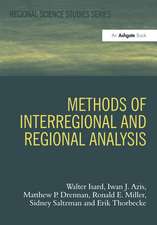History of Regional Science and the Regional Science Association International: The Beginnings and Early History
Autor Walter Isarden Limba Engleză Hardback – 18 iun 2003
| Toate formatele și edițiile | Preț | Express |
|---|---|---|
| Paperback (1) | 640.06 lei 6-8 săpt. | |
| Springer Berlin, Heidelberg – 20 iul 2012 | 640.06 lei 6-8 săpt. | |
| Hardback (1) | 644.18 lei 6-8 săpt. | |
| Springer Berlin, Heidelberg – 18 iun 2003 | 644.18 lei 6-8 săpt. |
Preț: 644.18 lei
Preț vechi: 757.85 lei
-15% Nou
Puncte Express: 966
Preț estimativ în valută:
123.26€ • 128.70$ • 102.02£
123.26€ • 128.70$ • 102.02£
Carte tipărită la comandă
Livrare economică 04-18 aprilie
Preluare comenzi: 021 569.72.76
Specificații
ISBN-13: 9783540009344
ISBN-10: 3540009345
Pagini: 288
Ilustrații: X, 274 p.
Dimensiuni: 155 x 235 x 22 mm
Greutate: 0.52 kg
Ediția:2003
Editura: Springer Berlin, Heidelberg
Colecția Springer
Locul publicării:Berlin, Heidelberg, Germany
ISBN-10: 3540009345
Pagini: 288
Ilustrații: X, 274 p.
Dimensiuni: 155 x 235 x 22 mm
Greutate: 0.52 kg
Ediția:2003
Editura: Springer Berlin, Heidelberg
Colecția Springer
Locul publicării:Berlin, Heidelberg, Germany
Public țintă
ResearchCuprins
1 The Setting and Initial Events.- 2 The Emergence and Struggling Years of Regional Science.- 2.1 Early Developments and Significant Recognition of Location Theory.- 2.2 Growth of Interest in Regional Problems, Informal Meetings of Regional Researchers and Promotion Efforts.- 2.3 Era of Conceptual Thinking and Model Development with Multidisciplinary Explorations.- 3 The Evolution of the Designations: Regional Science, Regional Science Association and the Field of Regional Science.- 4 The Formation of the Regional Science Association.- 5 The Rooting and Emergence of Regional Science as a Major Field of Study.- 6 The Invasion of and Extensive Expansion in Europe Concomitant with the Formation of Sections.- 7 The Spread of Regional Science into Japan, India, andLatin America.- 8 My Current Thinking on the Scope and Nature of Regional Science and Opportunities for Its Advance in Basic Research and Policy Analyses.- Appendix A: Memorandum on a Census Monograph on the Location of Economic Activity and Its Relation to Population.- Appendix B: Request for Support of a Project in the Field of Regional Economic Studies.- Appendix C: Regionalism and American Economic History. Lee Benson (12/9/51).- Appendix D: Conference of the Regional Science Association 4–7 September 1961, Institute of Social Studies, Molenstraat 27, The Hague, Netherlands.- Appendix E: Annual Programs in the United States, 1958–1967 (EXCEPT 1963).- Appendix F: Regional Science Association Council Members.- Reference.
Recenzii
From the reviews:
"This book is a fascinating read for anyone who has had any involvement in the events and activities of the Regional Science Association … . written from the perspective of the figure who is widely acknowledged to be the father of that field. … This book helps participants to understand better the origins and early inspiration for his evangelical role and how he came to give early momentum to the multidisciplinary movement … ." (Peter J B Brown, Environment and Planning B: Planning and Design, Vol. 31, 2004)
"This book is a fascinating read for anyone who has had any involvement in the events and activities of the Regional Science Association … . written from the perspective of the figure who is widely acknowledged to be the father of that field. … This book helps participants to understand better the origins and early inspiration for his evangelical role and how he came to give early momentum to the multidisciplinary movement … ." (Peter J B Brown, Environment and Planning B: Planning and Design, Vol. 31, 2004)
Textul de pe ultima copertă
The book portrays how a new unique social science field of study evolved and describes the formation of a society associated with the field. It starts with the rise of Hitler, the advent of the Keynesian Revolution, the intense mathematization of economics and relates how an individual's creative thinking, later supplemented by that of others, was able to effectively combat the strong resistance of conventional social sciences-economics and geography in particular to attain full scale recognition as a basic social science area covering the sorely neglected theoretical and related applied analysis of spatial, locational and regional phenomena. The book depicts the first stage of development in North America, then because of demonstrated applied findings on problems where only theory and just talk existed in economics and geography, spread rapidly into Europe, then Japan, India, Australia, South Korea and Latin America, and recently into Indonesia and China and elsewhere. It has become today, in the mind of the founder and author, to be among the leading areas of study (if not the leading one) in attacking the globalization problems -economic, political and cultural- of the world economy and its major regions.
Caracteristici
A well-written and exciting historical account of the way in which a new unique social science field of study, Regional Science, and the formation of the society associated with the field, Regional Science Association International, developed. The text has been written by the founder of the Regional Science Association and current President of the North American Regional Science Council. Includes supplementary material: sn.pub/extras








